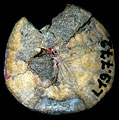The Echinoid Directory
Fauraster Lambert in Lambert & Thiery, 1924, p. 396
| Diagnostic Features |
|
|---|---|
| Distribution | Upper Cretaceous (Maastrichtian) of Spain. |
| Name gender | masculine |
| Type | Fauraster priscus Lambert, in Lambert & Thiery, 1924, p. 396; by original designation. |
| Species Included |
|
| Classification and/or Status |
|
| Remarks |
|


